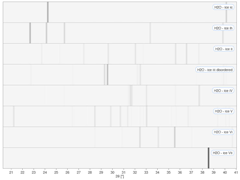
Postulated theories for this include fetal RBCs express less ABO blood group antigens than adult levels and that ABO blood group antigens are expressed by many tissues, which reduces the chance that antibodies specifically target the antigens on fetal RBCs. Compared with FMH, ABO incompatibility generally causes a less severe form of HDFN. The anti-A and anti-B antibodies are IgG, which can cross the placenta and affect the developing fetus. If the mother's fetus has an A or B (or AB) blood type, these maternal anti-A and/or anti-B antibodies, respectively, will attack the foreign blood type of the fetus. In ABO incompatibility, naturally occurring antigens against A or B blood types are present in mothers with O blood type. Only about 1% of those pairs, those with high IgG titers, will develop HDFN due to ABO incompatibility. First, the fetomaternal pair can have inherent ABO incompatibility, which occurs in 15 to 25% of pregnancies. As such, it is important to consider HDFN at all stages of the pregnancy where FMH may occur.Īs mentioned, there are two mechanisms causing hemolytic disease of the fetus and newborn. In fact, 15 to 50% of gestations have sufficient fetomaternal hemorrhage to cause alloimmunization, and only 1 to 2% of all Rh alloimmunization is caused by antepartum FMH. This frequently occurring Rh-incompatibility increases the risk of HDFN with any FMH event.Īs little as 0.1 mL of fetal blood entering maternal circulation is sufficient to cause alloimmunization. Among white women, an Rh-negative woman has an 85% chance of mating with an Rh-positive man. The Rh-negative blood type is most predominant in white races (15%) compared to African Americans (5% to 8%) or Asians and Native Americans (1% to 2%). Rh incompatibility varies by race, ethnicity, and risk factors. Thus it is important to stay vigilant for the development of HDFN. However, despite adequate RhD immunoprophylaxis, an estimated 1 to 3 in 1000 Rh-negative women still develop alloimmunization today. The incidence of HDFN decreased even further to 0.1% with the administration of antepartum RhD immunoprophylaxis.

Rhesus D-negative (RhD) immunoprophylaxis was first introduced in 1968, which dropped the incidence of HDFN from 1% of all newborns worldwide (with 50% mortality) to 0.5%.


Diamond in 1932 when he wrote about erythroblastosis fetalis in the newborn based on peripheral smears. Hemolytic disease of the fetus and newborn was first described by Dr.


 0 kommentar(er)
0 kommentar(er)
